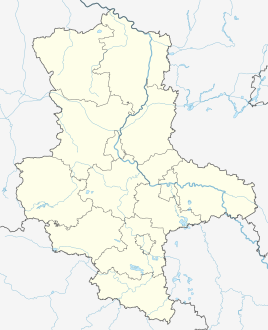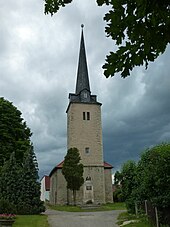Rehmsdorf
|
Rehmsdorf
Municipality Elsteraue
|
||
|---|---|---|
| Coordinates: 51 ° 3 ′ 30 ″ N , 12 ° 12 ′ 56 ″ E | ||
| Height : | 184 m | |
| Area : | 10.35 km² | |
| Residents : | 1126 (March 4, 2007) | |
| Population density : | 109 inhabitants / km² | |
| Incorporation : | July 1, 2003 | |
| Postal code : | 06729 | |
|
Location of Rehmsdorf in Saxony-Anhalt |
||
Rehmsdorf is a village in the Elsteraue municipality in the Burgenland district in Saxony-Anhalt .
geography
Rehmsdorf is located on the southwestern edge of the Leipzig lowland bay .
The districts of Krimmitzschen and Sprossen as well as the residential area Rumsdorf belong to the village of Rehmsdorf . The places Oberhaide and Wuitz were devastated as a result of the lignite mining of the Zipsendorf-West and -Süd opencast mines in 1938–1940 and 1954–1956. Their corridors also belong to Rehmsdorf.
history
Rehmsdorf was most likely founded by local Slavs . Rehmsdorf is first mentioned in a document in 1121 as Rodewanesdorph . The decisive factor for this was the Posa monastery near Zeitz , because the monks resident there were able to write. The Rodewanesdorph settlement had to pay taxes to this monastery. The hall church of Rehmsdorf was built in 1704. The manor with the manor house built by August Friedrich von Ende in 1750 determined the life of the place for centuries.
The area of today's village of Rehmsdorf, d. H. the places Rehmsdorf, Oberhaide, Rumsdorf, Krimmitzschen, Sprossen and Wuitz were in the Zeitz office until 1815 , which as part of the Naumburg-Zeitz bishopric had been under Electoral Saxon sovereignty since 1561 and belonged to the secondary school- principality of Saxony-Zeitz between 1656/57 and 1718 . The decisions of the Congress of Vienna , the six places came in 1815 to Prussia and were in 1816 the county Zeitz in the administrative district of Merseburg of the Province of Saxony allocated.
When lignite was discovered at a shallow depth in 1820, the village turned into an important industrial site. An open pit mine, a briquette factory and a chemical factory were built. To open up new sales markets for coal, the Zeitz – Altenburg railway line was opened in 1872 , and Rehmsdorf and Wuitz each received a train station. In 1901 the railway line from Wuitz-Mumsdorf to Gera-Pforten opened . After the "Neuglück" mine was closed in 1932, the former open-cast mine became a natural swimming pool. The towns of Oberhaide and Wuitz to the east of Rehmsdorf formed the westernmost foothills of the Meuselwitz-Altenburg lignite district . Several smaller opencast mines were also in operation in the area.
In 1928 the previously independent municipalities of Rehmsdorf and Rumsdorf merged to form the municipality of Rehmsdorf. Some half-timbered buildings still adorn the two village centers, which were built around 250 years ago. In 1932, one of the most modern schools of the time was built in Rehmsdorf, which is now the primary school and educational institutions for retraining students. Between 1938 and 1940, the 30 residents of the Rehmsdorf district of Oberhaide had to leave their homes due to the Zipsendorf-West opencast mine . Most of them moved to Wuitz , which, however, met the same fate between 1954 and 1956 with the Zipsendorf-Süd opencast mine .
From the end of December 1944 to 11 April 1945 the station was located near the Rehmsdorfer the outer bearing will the Buchenwald concentration camp . The prisoners were used in the reconstruction of the destroyed hydrogenation plant of BRABAG (lignite-gasoline AG). Imre Kertész , who later won the Nobel Prize for Literature, was among the forced laborers . After the end of the Second World War, the barracks of the camp were used as a reception camp for displaced persons . Today a memorial stone opposite the station building and the exhibition and documentation center in the community center Rehmsdorf on Brunnenplatz bear witness to this past.
After Krimmitzschen became a district of Rehmsdorf before 1950, sprouts followed on July 1, 1950, and the corridor of Wuitz , devastated in 1956, followed on July 1, 1961 , of which only the Wuitz-Mumsdorf train station and the briquette factory survived the dredging. Since 2002 there have been no more trains on the Zeitz-Altenburg railway line, which meant that Rehmsdorf station lost its importance.
On July 1, 2003, Rehmsdorf formed the new Elsteraue municipality with nine other municipalities .
politics
Local mayor is Thomas Heilmann.
coat of arms
Blazon : “In blue, a golden, red-roofed castle with a flight of stairs in front of a central gable, black door and black windows, a small turret with black window and black weather vane. A golden oak leaf with two golden acorns each on the right and left above the house. Under the house, in a silver semicircular shield, an overturned red sword with a round head, handle and round corners of the rapier rod, crossed diagonally with a red key, the beard turned downwards, the keeper square. "
traffic
The Rehmsdorf station was on the Zeitz – Altenburg railway line . Passenger traffic has not taken place since 2002. The Sprossen airfield is located north of the federal highway 180 .
literature
- Municipality of Rehmsdorf (ed.): Rehmsdorf in the course of time n.d. (approx. 1992)
Individual evidence
- ^ Karlheinz Blaschke , Uwe Ulrich Jäschke : Kursächsischer Ämteratlas , Leipzig 2009, ISBN 978-3-937386-14-0 , p. 86 f.
- ^ The Zeitz district in the municipal directory 1900
- ^ History of Oberhaide
- ↑ Josefine Janert: The houses were always there. In the daily newspaper , 7./8./9. April 2007
- ^ Rehmsdorf and its districts on gov.genealogy.net
- ↑ Disappeared places of the Meuselwitz-Altenburg lignite mining area in a PDF document from the LMBV
- ↑ StBA Area: changes from 01.01. until December 31, 2003







